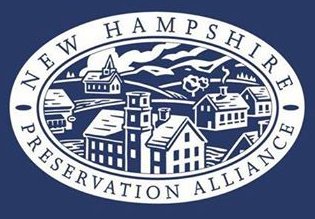Chase's Mill Revival Underway
Three preservation projects – each located in communities suffering from the decline in the forest products industry – are moving forward this spring thanks to grant funds awarded by the New Hampshire Preservation Alliance. The projects in Alstead, Lancaster and Colebrook each showcase the important synergies between historic preservation, economic development and community revitalization. The N.H. Preservation Alliance joined with its counterparts in Vermont, Maine and New York to create the Northeast Heritage Economy Program for historic properties in need of reinvestment, funded by the Northern Border Regional Commission.
Chase’s Mill, Alstead
Chase’s Mill in Alstead, shown here, during earlier stages of repair to the foundation and adjacent dam.
For most of the last 253 years, there has been a working, water-powered mill at the mouth of Lake Warren in Alstead. In 1910, the mill was purchased and renovated by architect Hartley Dennett, who repurposed its 18th and 19th century timbers and salvaged parts from nearby mill ruins. In the spirit of community, he opened its doors for use by his neighbors. His stepson, Heman Chase, inherited the property in 1936 and expanded Dennett’s tradition by teaching shop and woodworking classes to children and adults and by hosting community gatherings in a large room above the shop. After Chase’s death, the mill passed to other owners, eventually falling into decline.
In 2012, the Mill Hollow Heritage Association (MHHA) formed as a non-profit to purchase, renovate and reopen the historic structure, one of only nine operable water-powered sawmills left in the state. The group successfully raised funds to complete repairs to the mill’s siding and windows and to the adjacent dam and in 2016 listed it to the New Hampshire State Register of Historic Places.
The historic turbine inside Chase’s Mill.
MHHA Board President Sharon Spaulding explains the current project: “Especially in uncertain times such as these, we are grateful to be a recipient of a Northeast Heritage Economy Program grant of $78,622. These funds from the Northern Border Regional Commission will help make Chase’s Mill – an historic, water-powered mill with foundation stones dating to 1767 – welcoming to all. This award will enable us to build an ADA lift, install plumbing and a septic system, and enhance parking. When we open in July, Chase’s Mill will become a center for hands-on learning for children and adults, and a place where the community can gather. Our waterpower preserves New England’s industrial past, while illustrating a sustainable, carbon-free energy source to inspire our future.”
The Mill Hollow Heritage Association is powered by a clear vision of what residents and visitors will experience when they step inside the completed project at Chase’s Mill. Sharon Spaulding again explains:
“Visitors will step into a past once again thrumming with life. Inside the newly renovated Arts and Crafts structure that rests on foundation stones dating to 1767, your eyes will adjust to light filtered by old, wavy glass panes and the leaves from hemlock, cherry, and oak trees outside. You’ll hear the whoosh of Warren Brook as it tumbles over river rock and powers the mill’s turbines on the lower floors.
“Still on the main or shop floor, you’ll see a variety of hand tools including both antique and modern saws and planers hanging from 18th and 19th century timbers. You’ll hear the thunk and whir of foot-powered lathes as students and craftspeople shape wood into bowls, benches, and boxes. You might join the class or take another one on how to make basic household repairs.
A view of Chase’s Mill from the brook.
“Walking down a steep set of stairs, you’ll smell the damp earth and watch as water, now roaring, spins the refurbished turbines. These in turn, power the shafts and belts of machinery in use on the shop floor above. Physics in action.
“Returning to the shop floor, you notice another flight of stairs leading to the large community space above. Here, you’ll see exhibits on topics that include the history of water power and its importance in the development of rural New England, or on its potential as a source of sustainable energy. Tucked under the eaves of the room’s large dormers, you can explore working models on hydropower, or simply trace the path of the brook below letting your imagination wander. You might also gather with friends in front of the large stone hearth to hear book talks or lectures, or to learn Word Craft through storytelling and creative writing. Perhaps you’ll return for a small concert or to pick up a pencil in a class on drawing.
“Outside, following a self-guided nature path, you’ll see the ruins of other mills that once stood nearby. Across the road, as the brook flows from the mouth of Lake Warren, you might experiment with building small dams from sticks, or test out the sea-worthiness of a model ship you’ve just made in shop class.”
In 2009, the N.H. Preservation Alliance’s Seven to Save program recognized Chase’s Mill as an endangered historic building that deserved recognition and support. The current project will successfully remove the building from the Seven to Save list! For more detailed information, visit https://nhpreservation.org/seven-to-save and http://www.millhollowheritageassociation.org/
To learn more about the Northern Border Regional Commission winners, click here.



